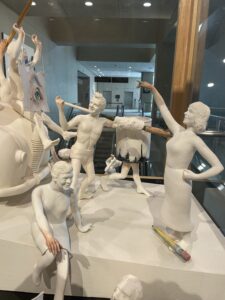A Visit with the wildly original Patti Warashina



What a treat to talk with Patti Warashina, the legendary Seattle-based ceramic sculptor. Warashina has been creating wildly original artworks for decades. Based on her own invented figural form, a detailed face, hands and feet , uninhibited by anatomy, they perform incredible acrobatic feats. She wants her figures to represent humanity in general rather than a specific person.
The big exception to that point of view is her 1986 Procession the Seattle Art Scene with 72 artists, driving and dancing over a Ming style semicircular bridge. Warashina took multiple polaroids of each person and then created recognizable faces. Not only that the figures also have props, such as a real pencil or brush (perhaps scaled down for the sculpture). Procession celebrates the artists and the lively art scene.




Warashina first emerged as part of an informal group of ceramic artists in the Northwest who were moving beyond the vessel tradition in the late 1960s and early 1970s. The “ Poke in the Eye” exhibition at the Seattle Art Museum is a refreshing look at this quirky art of the Northwest and California that continued into the 1980s. These artists rejected both the abstract expressionist obsession with inner drives as well as the slick surfaces of New York Pop. Peter Voulkos pioneered clay as sculpture with huge slabs that he pierced in various ways. Artists such as Robert Arneson and Howard Kottner created ceramic sculpture filled with humor, irony and even cynicism in the late 1960s and early 1970s.

Patti Warashina’s works in the show like Airstream Turkey are classic examples of funk art.
At the time she went to undergrad and grad school in the early 60s, there was a turn away from figure drawing and sculpture, as a rejection of classical approaches. But as an undergraduate she took one drawing course as an elective ( her parents wanted her to be a dental hygienist), and was hooked on art. Then she happened to see people making hand built clay pots with slabs of clay, So she turned to clay, first punching, and coiling, then using the wheel and painting and drawing on the pots.
When she was hired to teach at UW in 1973, her colleague Harold Kottler was already working with a funk attitude and she joined him. Thus from accidentally moving toward clay, she became part of pioneering changes to clay tradition. But as she was immersed in a male dominated scene, she decided to branch out into her own sense of humor and aesthetic
 One of my favorite themes from this era is the Kiln Series. It was inspired, the artist explained, by the constant kiln talk among “the guys” including a cart loading technique for the kiln. Warashina’s wonderful take on the idea, turning the cart into an actual model of a car: as it drives into the kiln it becomes a brick car. Warashina made a series of kiln sculptures between 68 and 72, then car sculptures starting in 79 that continued into the late 80s.
One of my favorite themes from this era is the Kiln Series. It was inspired, the artist explained, by the constant kiln talk among “the guys” including a cart loading technique for the kiln. Warashina’s wonderful take on the idea, turning the cart into an actual model of a car: as it drives into the kiln it becomes a brick car. Warashina made a series of kiln sculptures between 68 and 72, then car sculptures starting in 79 that continued into the late 80s.

Cats became another theme of her work, based on a Japanese cat (nekko.) She was asked to do one and then she made a whole series starting in 2013. These were seen in a major exhibition at the Bellevue Art Museum.
As she explained, there is a lot of serendipity as she changed from one theme to another, pyramids, cats, cups. Her role as a foundational part of the funk movement in the NW ceramics world is only part of her story. Her work has many layers: sophisticated firing techniques, drawing, subtle statements on the state of the world, as well as absurdity.
Many of them present us with empowered women.
Patti Warashina’s recent exhibition, “The World Upside Down,” at the Travor Gallery, spoke to our immediate moment.
The figures escape a trouble filled globe, climbing away from it.

Just to give one example, in Double Trouble, two of her characteristic figures are back to back, the lower one on a bright red globe with indications of flames. Under that figure and the red globe is a base depicting the solar system with representations of the sun, and planets, but we also see in another strip of detailed drawing, specific references to salmon, guns, nationalism and other intense topics.
The figures themselves, partly covered in black paint to suggest a mask on the face and tight leggings, fling their arms out and pump their legs uselessly in mid air. They want to escape but seem to be only flailing. The top figure spears somewhere between joyful and anxious. She immobilizes the figure under her.
There is nothing funk about this series of works. The artist said she was storytelling, although she does not write the stories. These figures have four or five glazes fired at different temperatures. They include detailed painting and drawing. They are sophisticated examples of what ceramics can do in the hands of a master artist. They are also clearly referring to the current state of the world.

This entry was posted on November 26, 2024 and is filed under Uncategorized.








